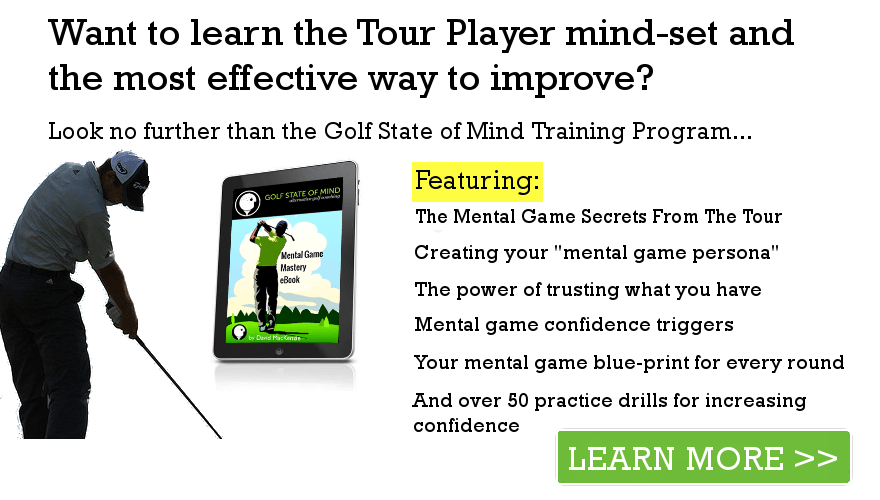1. Become your inner caddy
If you get into the habit of beating yourself up after bad shots, you’ll start to subconsciously fear your own criticism and increase your anxiety levels over the ball. Have a mechanism which gets you back to neutral quickly after a poor shot. This could be a phrase, a deep breath or set number of steps after the shot. Imagine what a good caddie would say to a player to pick him or her up – something like “forget about it”. Whatever it is, the key is to re-frame quickly after, so you don’t let it set in and affect your mood ahead of the next shot.
2. Find your optimal level of arousal
You’re much more likely to shoot your best score in competition. The reason is that to play your best you need to be aroused to a certain level, which increases your power of concentration and competitiveness. Remember this next time you feel nerves – they are actually a positive. But you need to be able to get fired up without crossing the line to anger, frustration or even choking. Sam Snead used to play his best golf when he was in a mental state he called “cool mad”.
3. Don’t Give Yourself Technical Feedback on the Golf Course.
Giving yourself technical feedback diminishes your confidence because you are essentially admitting to yourself that you have doubt about your golf swing. As Bob Rotella says, “If you are trying to tell your body how to swing, you are telling yourself you don’t know how to swing.” Thinking about technique means your focus is “internal”, not “external’ which is where it needs to be. The more internal your focus, the less fluid and smooth the action is. Think about throwing a basketball or a dart. Would your focus be on your body or the target? Even though you can’t see the target in golf you need to make it as similar as you can to other target sports. You can do this by holding onto the image of the target and the path the ball will take (even when you’re over the ball), and let your body react to that imagery.
4. Visualize success
Visualization is a key factor in hitting good golf shots. Jack Nicklaus said: “I feel that hitting specific shots — playing the ball to a certain place in a certain way — is 50 percent mental picture, 40 percent setup, and 10 percent swing.”
The more you can build a vivid mental image of the shot you want to hit (trajectory, shape and what it will do when it lands), the better the chance of your body moving in a way that will produce that desired result. Have you ever been amazed at yourself when you’ve hit a miracle shot out of the trees? It’s most likely because the situation forced you to have a very clear image of the shot.
Make sure this visualization is a key part of your routine for every shot.
5. Make routine your sanctuary
When you have a clearly defined pre-shot routine, you can feel confident you have approached the shot correctly.
This is your bubble, your time to get into your “ideal performance state” and give yourself the best opportunity to hit the shot you intend. If you do this, you can’t be too upset with the outcome.
Make the sequence repetitive and it will squeeze out the time for any doubt and negative thoughts, so you feel maximum confidence ahead of pulling the trigger. If you need help building a good routine, then check out my mental game training program, which is on sale for 50% off until Sunday.
6. Change Your Goals for your round
Make the “process” of hitting good golf shots your goal for the round instead of shooting your best score. This means making the shot routine the number one priority.
Going to the course with the goal of shooting a great score, only creates pressure and causes you to relate the outcome of every shot to your larger goal of score. If a great score is your goal, what happens when you double bogey the first? When focus on process, you shift your focus from what is out of your control (your score), to what is 100% within your control. This will take the pressure off and increase the chances of you achieving what you ultimately want – those good scores!
7. Stay present
One of the keys to becoming a better player is quickly letting go of the past and staying in the present. When you move between the past and future, it has a negative effect on your game. Let’s say you’ve just shot your best nine holes ever. Where is your focus likely to go after that? Probably to the possible glory at end of the round. All this is going to do is increase anxiety and tension in your game, causing poor shots. The same thing happens when you hang onto that missed 3 footer on the last hole or out of bounds tee shot. The only time I would recommend going into the past is to recall great shots you’ve hit before. Otherwise, try to stay present and in a calm place.
Bonus tip
After a round, focus on what you did well. Even if you scored way over your handicap, there’ll be at least 3 things you did well. Find one thing you need to work on. Write them down along with your most memorable shots of the round in a “mental game journal”. Start to develop an image reel of your best shots that you can use to give yourself a boost during rounds. Imprinting those more successful images from your round in your mind will help build confidence.
Photo by Tour Pro Golf Clubs

